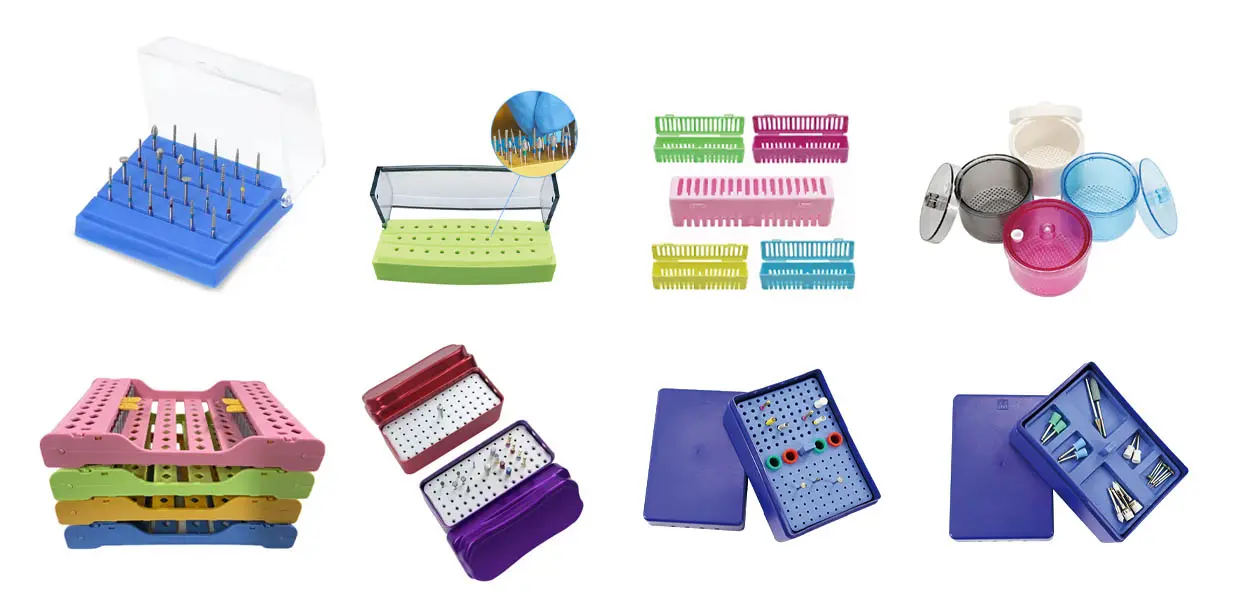Dental instruments come in a wide variety, and they are crucial for ensuring the successful completion of dental examinations or surgeries, as well as improving the efficiency of dental procedures. Given the importance of dental instruments, their hygiene must be strictly controlled to ensure sterility. This is why dental clinics use various types of dental sterilization boxes to sterilize different dental instruments. There are different types of sterilization boxes available to accommodate various instruments.
This article will introduce you to some of the best dental sterilization boxes. It will explain how dental sterilization boxes work, how to use them, and important considerations when using them. Let’s explore dental sterilization boxes together!
1. Why is it important to choose high-quality dental sterilization boxes?
As stated by the NIH, “The goal of instrument processing is to protect patients by preventing cross-contamination from instruments. The process involves a series of sequential steps aimed at removing and killing microbes on contaminated instruments and maintaining those instruments in an aseptic state until they are reused.” The primary function of dental instrument disinfection is to remove and kill all microorganisms on the instruments, maintain their sterility, and protect patients from cross-contamination. Sterilization boxes are essential for this process. Below, we will explain why it is important to choose the best sterilization box from several perspectives:
1.1. Ensure effective sterilization of dental instruments
Different types of dental instruments require different sterilization methods, so different types of dental sterilization boxes are selected accordingly. Using substandard sterilization boxes may result in incomplete sterilization or even damage to the instruments. For example, metal instruments such as dental drills and forceps require high-temperature, high-pressure sterilization at 134°C. Some substandard plastic sterilization trays may melt at this temperature, leading to sterilization failure and potentially causing damage to the instruments by adhering to them.
1.2. Reduce the proliferation of drug-resistant bacteria
Incomplete disinfection may lead to the reproduction of drug-resistant bacteria. Dental sterilization boxes made from substandard materials and with misrepresented sterilization parameters may result in incomplete disinfection, which over time can cause bacteria to develop drug resistance. However, dental sterilization boxes made by reputable manufacturers, they selected the quality materials and sterilize efficiently and thoroughly, leaving no place for bacteria and other microorganisms to hide.
1.3. Compliance with hygiene standards and legal requirements
The safe use of dental instruments is related to the physical health and comfort of patients. Therefore, many countries and regions have strict hygiene standards and legal requirements for dental supplies disinfection. Choosing the best dental sterilization boxes not only helps meet these requirements but also avoids legal issues or patient complaints due to inadequate disinfection.
For example, one of my dental clinic clients had a dispute with a patient over pricing. Subsequently, the patient filed a complaint with the local health department, alleging that the dental clinic used substandard dental sterilization boxes for sterilization. After an inspection by the health department, it was found that a batch of outdated(not meet the new health standards) sterilization boxes, which had not been replaced in time, were fined and are now facing potential lawsuits from patients.
1.4. Enhancing Work Efficiency
Well-designed dental sterilization boxes are more scientifically sound and can significantly improve sterilization efficiency and success rates. Especially when there are a large number of instruments that need sterilization, this advantage is very obvious and can greatly improve work efficiency.
1.5. Protect instrument lifespan
Some sterilization methods can cause minor damage to instruments, such as high-temperature and high-pressure sterilization or disinfectant immersion. However, high-quality dental sterilization boxes can provide some protection for instruments, thereby extending their lifespan.
2. 4 Common types of dental sterilization boxes to choose from
2.1. Dental Bur Holder
A dental bur holder is a common type of dental sterilization box, typically featuring a multi-hole design with various models available, including 18-hole, 24-hole, 30-hole, 40-hole, 80-hole, and 128-hole configurations. These boxes have holes of different sizes to accommodate dental burs of various dimensions. Both high-speed and low-speed dental burs are fully compatible. The material used to manufacture dental bur holders is medical-grade PP or stainless steel.
High-quality dental bur holders typically come with a lid to prevent burs from being lost. Dental burs are generally sterilized using high-temperature, high-pressure steam sterilization. Before sterilization, the burs are thoroughly cleaned, then inserted into the holes of the dental bur holder according to their type, and finally placed in autoclave steam sterilizer for sterilization. Dental bur holder not only ensure safe sterilization of drills but also serve as excellent storage containers. They allow different types of drills to be stored in an orderly manner, enabling dentists to quickly locate the right drill models and thereby improve work efficiency.
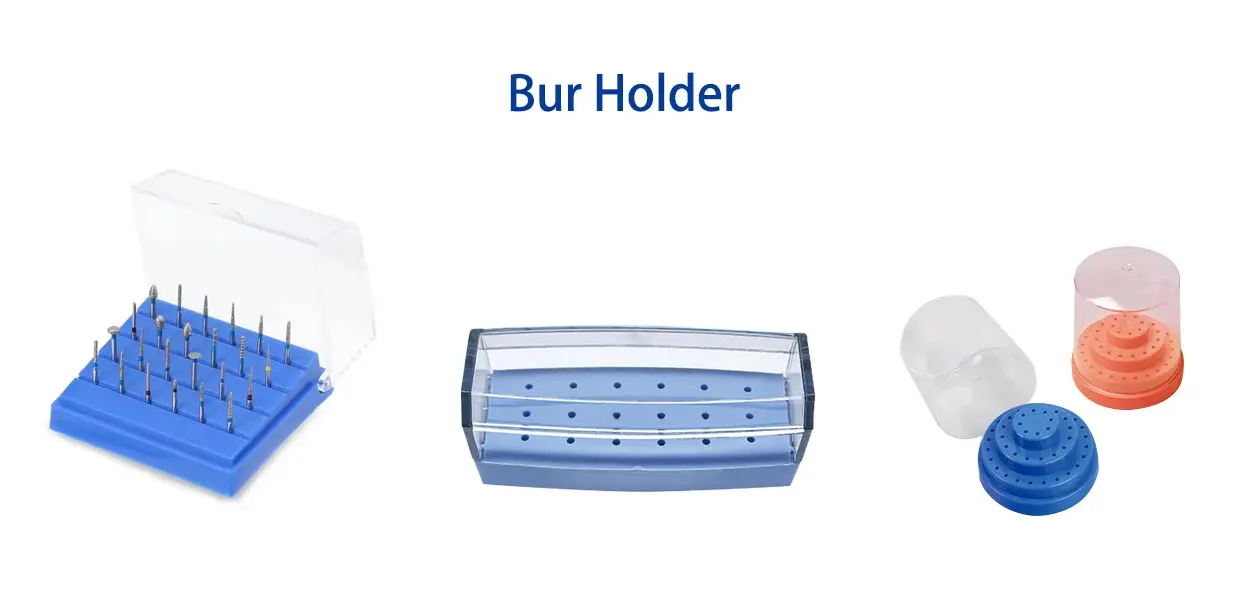
2.2. Dental Autoclavable Sterilization Box
Dental autoclavable sterilization boxes are typically rectangular or cylindrical in shape. As a universal dental instrument sterilization box, it is made of medical-grade plastic or stainless steel, resistant to chemical disinfectants and high temperatures and pressures. It is ideal for sterilizing forceps, tongue depressors, and dental pliers.
The dental sterilization box is compatible with both chemical disinfection and autoclave steam sterilization. Its perforated design facilitates the circulation of liquids or high-pressure steam, ensuring efficient sterilization.
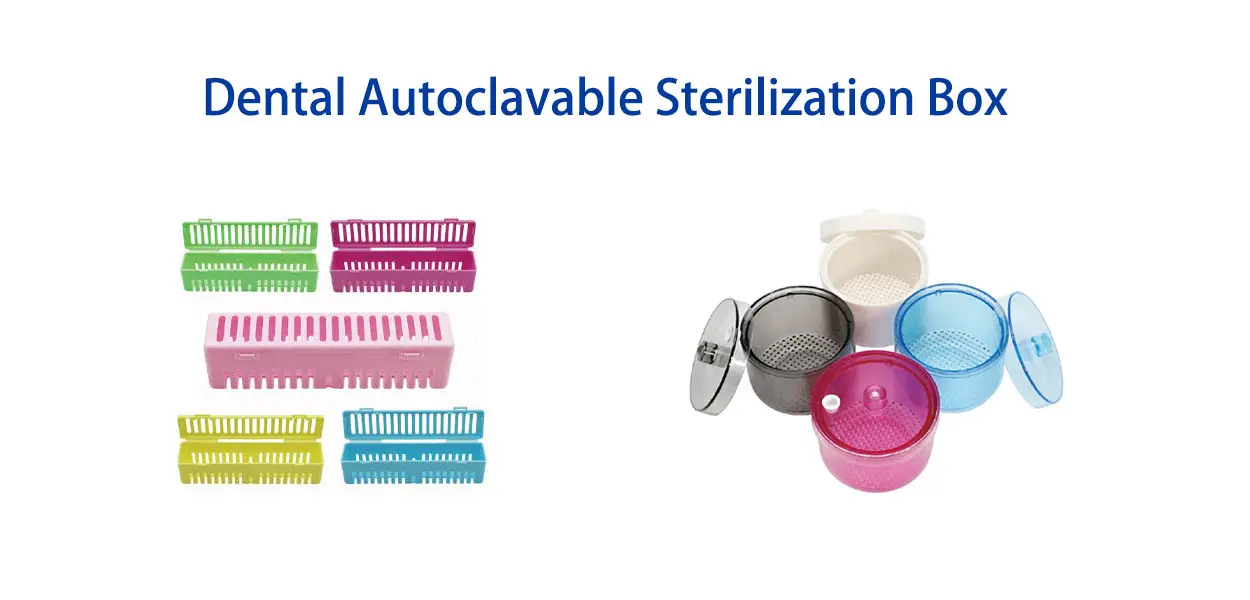
2.3. Dental Cassette Rack
The Dental Cassette Rack is another type of dental sterilization cassette. It not only sterilizes instruments but also serves as a storage solution for dental instruments, facilitating organization. This keeps the operating table clean and tidy, allowing dentists to quickly locate the required instruments and improve work efficiency.
The Dental Cassette Rack typically features a grid perforated design for excellent ventilation, aiding in rapid drying of instruments. The interior includes partitions to separate different types of instruments, while the exterior has a locking mechanism to securely hold all items in place and prevent movement. The rack body adopts a rectangular flat design, allowing for stackable storage to optimize space efficiency. Dental Cassette Racks are made of medical-grade engineering plastic or stainless steel, ensuring durability and reliability. Even when subjected to impacts or compression, they protect the instruments inside from damage. They are typically used for autoclave steam sterilization and can be disinfected at temperatures up to 134°C.
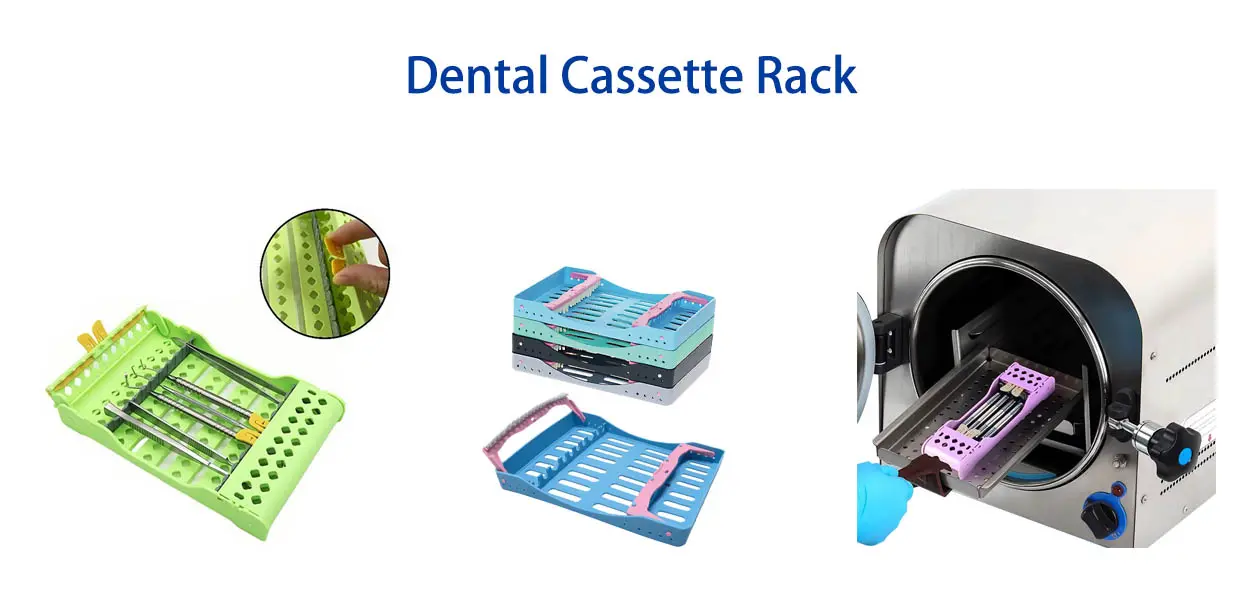
2.4. Dental Endo Box
I’m sure most people has seen this kind of dental sterilization box. It comes in many types, including single-layer perforated models and multi-layer drawer-style models. Single-layer dental endo boxes are similar to bur holders, featuring a porous structure that can also hold files, root canal files, etc., but with better sealing properties and typically made of stainless steel. Multi-layer drawer-type models are more common, combining perforated structures with square storage compartments. Multi-layer dental endo boxes are generally made of high-quality plastic and can withstand autoclave sterilization.
Dental endo boxes are divided into multiple functional storage zones, capable of holding various dental instruments or accessories such as dental drills, gutta percha points, absorbent paper points, polishing discs, polishing brushes, dental wedges, and more. Due to its ability to store so many commonly used dental tools, it is the most widely used type of dental sterilization box.
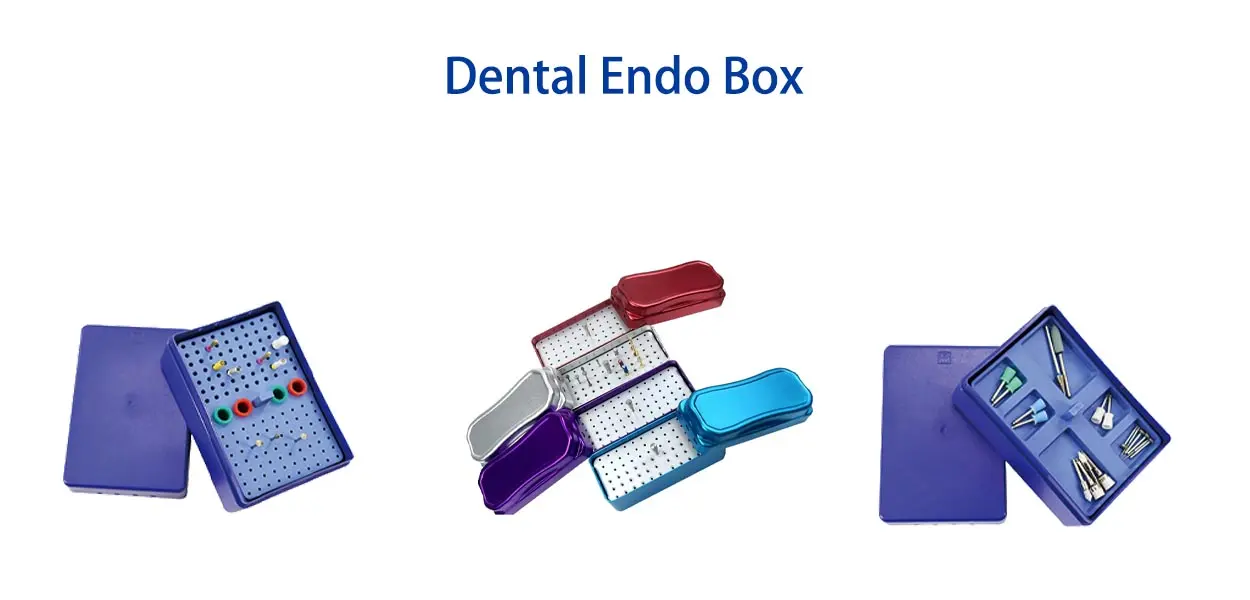
3. What materials define a high-quality dental sterilization box?
Materials have a significant impact on the quality of dental sterilization boxes, especially since there are various sterilization methods available. The sterilization box must not only withstand these sterilization methods but also ensure that the instruments inside are thoroughly sterilized. This places high demands on materials and design. Only dental sterilization boxes with excellent quality and scientific design can possess these functions. Let’s take a closer look at the material selection for dental sterilization boxes:
3.1. Medical-grade PP plastic
PP-material dental sterilization boxes are resistant to chemical reagent corrosion, high temperatures, and high pressure, and can also withstand high-intensity UV sterilization. It is relatively light in weight and is more suitable for carrying and moving. Compared with stainless steel materials, dental sterilization boxes made of PP materials have much lower impact resistance and heat resistance. However, it offers better cost-effectiveness than stainless steel. Also, its resistance to chemical reagent corrosion is superior to that of stainless steel. Therefore, if economic benefits are taken into account, the purchase ratio of PP material dental disinfection boxes can be increased.
For sterilization using strong acid or alkali chemical disinfectants, PP-material sterilization boxes are recommended. For autoclave steam sterilization, stainless steel-material dental sterilization boxes are preferable.
3.2. Stainless steel
Dental sterilization boxes made of stainless steel have excellent high-temperature and high-pressure resistance, as well as good thermal conductivity, making them ideal for autoclave steam sterilization. Meanwhile, stainless steel also has excellent impact resistance and durability, It can generally be made into larger baskets or drawer-type disinfection boxes. This can disinfect many instruments at one time, greatly improving the sterilization efficiency, and is particularly suitable for medium and large-sized dental hospitals.
However, compared with plastic dental sterilization boxes. Its ability to resist corrosion from chemical reagents is slightly weaker. It is also quite heavy and not light enough. Then, its price is higher and its economic benefits are not as good as those of plastic dental sterilization boxes. But this is only a short-term consideration, as stainless steel has superior impact resistance. If used properly, its service life will be significantly longer than plastic sterilization boxes, thereby balancing the economic benefits.
In summary, both plastic dental sterilization boxes and stainless steel sterilization boxes have their respective drawbacks. By combining their advantages and using them in conjunction for dental instrument sterilization, both efficiency and cost-effectiveness can be achieved. For example, when performing autoclave sterilization on a large number of instruments, stainless steel sterilization boxes should be selected. When using chemical disinfectants to sterilize small instruments such as dental drills and root canal files, plastic dental sterilization boxes should be used. By fully leveraging their respective advantages, efficient sterilization can be achieved while also extending their service life.
3.3 Plastic vs Stainless Steel
| Feature | Medical-Grade Plastic (PP) | Stainless Steel |
|---|---|---|
| Heat Resistance | Good, suitable for high-temperature steam sterilization | Excellent, suitable for high-temperature steam and autoclave sterilization |
| Corrosion Resistance | Good, suitable for chemical disinfection | Strong, but may corrode in extreme environments |
| Weight | Lightweight, easy to carry | Heavy, inconvenient for handling |
| Durability | Moderate, may age with prolonged use | Extremely durable, suitable for long-term use |
| Cleaning & Maintenance | Easy to clean, but may wear | Requires regular maintenance, highly durable |
| Cost | Low, suitable for clinics with limited budgets | High, suitable for high-standard requirements |
| Lifespan | Shorter, may age with prolonged high-temperature exposure | Very long, can last for many years with proper maintenance |
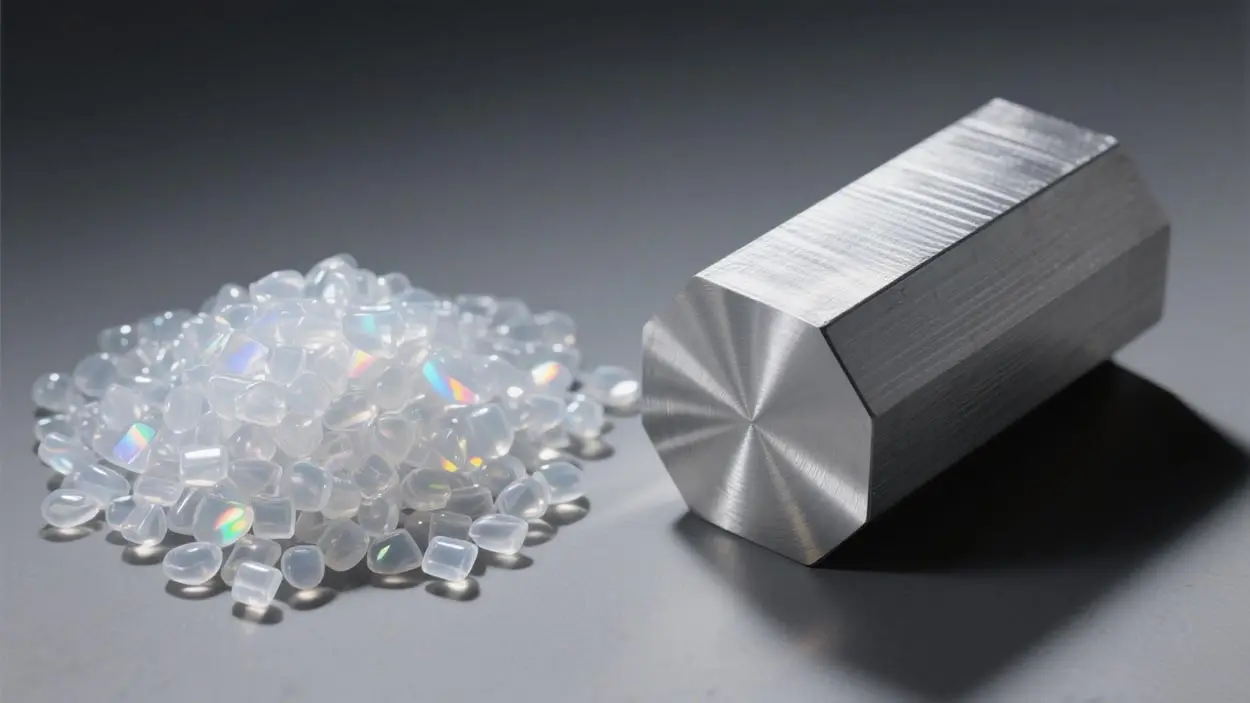
4. FAQs
1. What is the primary function of a dental sterilization box?
The primary function of a dental sterilization box is to store dental instruments that are to be sterilized or to store instruments that have already been sterilized. It ensures the sterile condition of dental instruments, prevents cross-contamination, and protects the instruments from damage during the sterilization process.
2. Which sterilization methods are compatible with dental sterilization boxes?
Dental sterilization boxes typically support the following sterilization methods:
- Autoclave sterilization: Suitable for high-temperature resistant tools, such as sterilization boxes made of stainless steel.
- Ultraviolet disinfection: Kills bacteria by irradiating with ultraviolet lamps.
- Chemical disinfection: It is carried out by soaking in disinfectant solution and is suitable for tools resistant to chemical corrosion, such as plastic sterilization boxes.
For the sake of sterilization efficiency and the service life of the sterilization boxes, it is recommended that multiple types of boxes be used in combination.
3. Do dental sterilization boxes need to be replaced regularly?
Generally, dental sterilization boxes do not need to be replaced frequently; regular inspections of their integrity are sufficient. Especially for plastic sterilization boxes, prolonged use may lead to aging, cracks, or breaks. Replacing these problematic sterilization boxes as needed is sufficient. As for stainless steel sterilization boxes, as long as incorrect sterilization methods are avoided, regular cleaning is performed, and they are kept clean and smooth, their service life is very long.
4. What temperature can dental sterilization boxes withstand?
There are generally two temperatures for sterilizing and disinfecting dental instruments: 121℃ and 134℃. Both high-quality plastic dental sterilization boxes and stainless steel sterilization boxes can withstand these temperatures. However, it is recommended to use stainless steel sterilization boxes for autoclave sterilization, as the properties of plastic materials mean that while they can withstand high temperatures, high temperatures accelerate plastic aging. To achieve more thorough sterilization and extend the lifespan of the sterilization box, autoclave sterilization methods should avoid using plastic sterilization boxes whenever possible.
5. Conclusion
Through the detailed exploration of different types, materials and disinfection methods of dental sterilization boxes. We figured out the importance of dental sterilization box and how to choose the right box according to the needs. Explore the properties of each material in depth to fully understand their advantages. By combining dental sterilization boxes made of various materials, we can leverage their advantages and avoid their disadvantages, making dental instrument sterilization safer, more efficient, and cost-effective.

